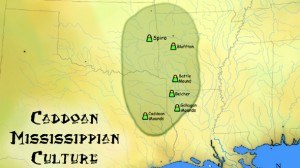The Archaeological Conservancy to restore Native American Mound in Fort Smith
by August 2, 2017 1:47 pm 2,446 views

Workers in early 2015 cleared brush around the Cavanaugh Mound in Fort Smith.
A Native American-constructed mound built possibly more than 900 years ago in Fort Smith that has been in a state of disrepair for decades will soon be stabilized thanks to funding from The Archaeological Conservancy.
The conservancy, a private, non-profit organization formed in 1980 to acquire and preserve important archaeological sites, purchased the Cavanaugh Mound in 2006 and has contracted with Steve Beam Construction to secure the site. Work is set to begin the week of Aug. 7.
The “Cavanaugh” Mound, located behind the New Liberty Baptist Church in south Fort Smith, is believed to have been constructed by Native Americans (possibly Caddo Indian ancestors) between AD 1100 and 1300. Caddo territory once included southwestern portions of Arkansas and northeast portions of Texas. It is believed the Caddo Indians built the mound in several phases. The mound was originally about 200 feet long at the base of each of the four sides and about 40 feet tall.
Tim Mulvihill, an archeologist with the University of Arkansas system and with the Arkansas Archeological Survey, and Jessica Crawford, southeast regional director for The Archaeological Conservancy, have worked together on the project for more than a decade.
Crawford and Mulvihill have said the mound was not likely used by Native Americans for burial, which would mean ancient artifacts are not buried within the mound. Mulvihill said the structure appears to be a “platform mound” on which a structure might have been built. An attempt to use radar to peer into the mound was attempted in March 2011, but the ground was too dry for usable data.
In February 2016, Crawford provided the following as an update on the work needed: “(A) large Mississippian/Caddo mound that was damaged many years ago by previous owners who, for reasons unknown, removed about a third of the mound and then later, dug a cellar in its side. The cellar was partially filled in and the ‘tunnel’ entrance is no longer visible. In recent years, the mound has developed a severe erosion problem. The seriousness of this problem was compounded when it became apparent that a historic cemetery on top of the mound (for which the head stones had also been removed by a previous owner) also began to erode. This really is a massive mound and it will require many truck loads of dirt to cover the eroding side. Before much can be done, several large trees must be removed from the top and sides of the mound.”

Mulvihill said he will monitor the work, and record any artifacts or other items of interest encountered during the stabilization. He said the conservancy is funding and managing the project.
“I’m very happy that it’s finally going to be done, and that the mound will be stabilized so it won’t erode anymore,” Mulvihill said.
